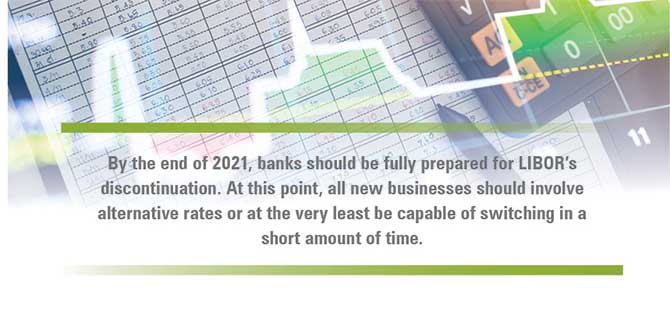By Tim Dominguez, Associate General Counsel, Compliance Alliance
The 1980s were a much different time than today. Many of us remember or are too young to remember an age where the typical computer only had 64 kilobytes of memory or where cell phones weighed as much as 20 pounds; no one anticipated we would ever call them smart any time soon. The 1980s were also a period of change for global economics and banks. In 1986, the London Interbank Offering Rate (LIBOR) was officially introduced and published as an interest rate benchmark for widespread usage by financial and non-financial firms in response to banks trading in new interest markets. However, over three decades later, after determining that LIBOR was vulnerable to interest rate manipulation, it was announced that the benchmark rate would be discontinued beginning Dec. 31, 2021. This discontinuation meant that many businesses, banks included, would have to take the arduous transition away from using LIBOR in the future and address existing products that already use it.
Under normal circumstances, 2020 was supposed to be a significant year in the transition away from LIBOR. However, the financial impact of the COVID-19 pandemic may have caused a shift in priorities for many banks. While regulators have provided a temporary reprieve in several banking areas for this year, it still stands today that LIBOR will no longer be here after 2021. To underscore the crucial need to address this issue by that deadline, the Financial Security Board (FSB) published a 2020 Progress report on the year of transition away from LIBOR. As the transition remains a global priority, the FSB also included a roadmap of milestones that banks should follow to navigate this process in a timely manner.
The FSB report addresses how the COVID-19 pandemic has been a “defining feature of the past year with widespread implications.” Understandably so; the pandemic has impacted many firms in their transition away from LIBOR. Still, according to a survey of FSB members, it has not created pressing substantive roadblocks to the transition. The report states that the direct correlation between LIBOR and banks’ overall borrowing costs weakened during the pandemic, with volatility leading banks to scarcely rely on LIBOR markets for funding. Those that did use LIBOR rates faced challenges because of the pandemic. While central bank rates were decreasing throughout the world, LIBOR rates were increasing, and those rates were passed on to borrowers when financial systems were supposed to play a role in providing much-needed liquidity.
Despite pandemic induced market disruptions, the FSB states that progress has been made throughout the past year in the transition. Many national working groups have produced their timely roadmaps as guides that have been widely adopted while also considering the economic impact of COVID-19. Over the past year, the FSB continued to work with the International Swaps and Derivatives Association (ISDA) to address the transition away from LIBOR in derivative contracts. In October 2020, ISDA released amendments to its definitions and protocols with these contracts and included new fallback language used by firms. This past year, more have adopted the Secured Overnight Financing Rate (SOFR) as the preferred alternative in U.S. dollar markets. Significant progress has indeed been made, and while regulators have launched a number of initiatives, what remains is for both financial and non-financial firms to globally lead the effort to a timely market transition by no longer issuing products linked to LIBOR and by modifying their legacy contracts linked to LIBOR wherever possible.
Currently, the FSB Global Transition Roadmap states that firms should already have identified all existing LIBOR exposures, including what will happen after 2021, and should also determine if those contracts have any fallback measures in place. Further, those who provide customers with products that reference LIBOR must plan to tell them about the transition and the steps being taken by the bank to move to alternative rates. Banks should now understand the industry and regulatory best practices with the transition away from LIBOR, including necessary steps taken with legal counsel’s assistance. By mid-2021, banks should have already determined which legacy contracts can be amended before the end of the year and consummate those changes where parties can agree. New contracts should contain robust alternative reference rates wherever possible by this time.

By the end of 2021, banks should be fully prepared for LIBOR’s discontinuation. At this point, all new businesses should involve alternative rates or at the very least be capable of switching in a short amount of time. In cases where it was impossible to amend legacy contracts linked to LIBOR, the implications of the benchmark rate no longer being published should have already been discussed, with necessary steps being taken to prepare for this kind of outcome. By Dec. 31, 2021, the goal is for all market participants, financial and non-financial firms alike, to operate without relying on LIBOR. To meet this, the importance of a market-led transition will remain significant throughout this year.
At the outset of LIBOR in 1986, no one could have predicted that over 30 years later, the rate would be discontinued and that a global pandemic would impact the transition. Just as 2020 was a significant year for the transition away from LIBOR, 2021 is equally, if not even more critical. If banks have not taken the necessary steps to address their potential LIBOR exposure for new and existing products, they must immediately put plans in place. The 1980s were indeed a different time compared to today. Just like computers with little storage space and phones as heavy as a sledgehammer, LIBOR is about to be an element left behind in the past. As we have adapted to technology changes, banks must also adapt to this change by properly preparing themselves and their customers.
Tim Dominguez joins Compliance Alliance after graduating from the University of Houston Law Center. During law school, he worked as an intern within the legal department of Frost Bank in San Antonio, TX. He also holds a Bachelor of Science in Communication Studies from The University of Texas at Austin. Before law school, Tim worked various jobs within the Texas state government, including the Texas Senate and the Texas Legislative Council. As one of our hotline advisors, Tim provides guidance to C/A members on a wide variety of regulatory and compliance issues, in addition to writing articles for some of our publications.
This story appears in Issue 4 2020 of The Arizona Banker Magazine.










